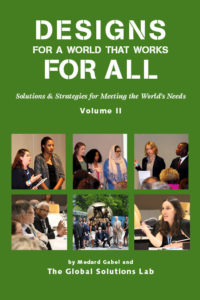DESIGN SCIENCE/GLOBAL SOLUTIONS LAB RESOURCES: Perspectives, Conceptual Tools, Global Data, Global Options
The following books provide examples of the work of the Global Solutions Lab and the methodology used to develop that work.
DESIGNS FOR A WORLD THAT WORKS FOR ALL
Solutions and Strategies for Meeting the World’s Needs: Volumes I–III
(2021- 2024 Editions)
The 2005–2024 Global Solutions Lab books, Volumes I, II, and III, are now available.
The 2005–2007 Design Science/Global Solutions Labs were held at the UN and the UN International School in New York City.
Since 2008, the Global Solutions Labs have been held at the UN in New York and Chestnut Hill College in Philadelphia. The 2020 and 2021 Labs were held virtually due to the pandemic. The 2022 Lab was held at Chestnut Hill College. The 2023 Lab was both virtual and in-person at Drexel University, the 2024 was virtual.
DESIGNS FOR A WORLD THAT WORKS FOR ALL
Solutions and Strategies for Meeting the World’s Needs: Volume I
Volume I contains:
PART I—Food & Water for All: Increasing Food Production/Decreasing Loss; Water Management; Governance
PART II—Clean Energy for All: Local Energy Systems; Regional Energy Systems; Global Energy Systems
Order Volume I soft-cover book here. Cost $7.00
NOTE: The Amazon listing for this book, Volume I and for Volumes II below, indicates that the book was published in April 2020. This is inaccurate. Both books are the 2021 versions. (The inaccuracy seems to be due to a technical issue with ISBN numbers.)
Download the free PDF here (8.8 MB)
DESIGNS FOR A WORLD THAT WORKS FOR ALL
Solutions and Strategies for Meeting the World’s Needs: Volume II
Volume II contains:
PART I—Education for All for Life
PART II—Global Health for All
PART III—Fair Economic Systems/Participatory Governance/Sustainable Life for All
PART IV—Human Rights for All
Order Volume II soft-cover book here. Cost $7.00
Download the free PDF here. (17 MB)
DESIGNS FOR A WORLD THAT WORKS FOR ALL
Solutions and Strategies for Meeting the World’s Needs: Volume III
(2024 edition)
Volume III contains:
PART I—Climate for All for Life
PART II—Electrifying Africa
Order Volume III soft-cover book here. Cost $8.00
Download the free PDF here. (5.8 MB)
Tools for Changing the World— A Design Science Primer
(New— 2024—edition of Design Science Primer)
Order Tools soft-cover book here. Cost $10.00
Download the free PDF here. (5.5 MB)
Context and Background/Perspectives, Tools and Systems
“Perspective is more important that IQ.” — Nicholas Negroponte
Systems are a way of seeing the world, of making sense, organizing of the world.
The following articles and papers provide additional context and background to the conceptual underpinnings of the Global Solutions Lab.
- Regenerative Design: Going Beyond Sustainability (92 KB)
- Buckminster Fuller & the Game of the World
- Buckminster Fuller: Leadership Principles (1.3 MB)
- Intro to Design Science (28 KB)
- Planning Diseases/Planetary Dis-Eases (56 KB
- Whole Systems Design (Autodesk) Video
- Light Weighting (Autodesk) (272 KB)
- Places to Intervene in the System
- Dancing with Systems
- Andrew Sheng, The One-Earth Balance Sheet
-
Links to almost everything UN: UN Agencies Links
By Buckminster Fuller:
- Humanity’s Critical Path (1.1 MB)
- Operating Manual for Spaceship
Earth (376 KB) - Reforming the Environment (24 KB)
- (Video) Economic System Based on Abundance Not Scarcity
Design Science (videos)
Design, Design Science, Design Science/Global Solutions Lab
Design Science Methodology
Design Science with Medard Gabel (60 minutes)
Making The World Work for Everyone
State of the world (videos and reports):
-
- Sustainable Development Goals
- 2020 State of the Planet Antonio Guterres, UN Secretary-General (Guterres talk begins at 5:27)
- UNDP Human Development Report 2020 Highlights
- Jeffrey Sachs: The Age of Sustainable Development, Part 1 and Part 2
- Hans Rosling: The best stats you’ve ever seen
- Russell Ackoff: From Mechanistic to Systemic Thinking
- Ellen MacArthur: The Surprising Thing I Learned Sailing Around the World
- Peter Diamandis: Imagining the Future: The Transformation of Humanity
- Johan Rockström: Planetary Boundaries— 10 years to transform the future of humanity – or destabilize the planet
- Partha Dasgupta: The Economics of Biodiversity (start at the 18-minute mark)
- Kate Raworth: Why it’s time for ‘Doughnut Economics
- Explaining the Circular Economy and How Society Can Re-think Progress
- Steve Jobs: On Collaboration
- Steve Jobs: Stanford Commencement Address
- Paul Hawken’s Commencement Address In Portland
- Hazel Henderson: Diagnosing the Economic Body Politic
- What Makes a City Sustainable?
- Thomas Friedman: The Price Is Not Right
- Towards Food Sovereignty: Reclaiming autonomous food systems
by Michel Pimbert
Global Statistical Data Sources
Data is what we use to define the world— where we are, the present state, where we have been, the past state, and where we are heading— the future state. This link is to a comprehensive list of global statistical data sources that are used in the design science process in the Global Solutions Lab to design and develop comprehensive solutions to global and local problems. Reliable global and local data are the foundation for implementable, effective design and change. The more innovative, radical, disruptive, or revolutionary the change, the more solid and convincing the data needs to be.
Global Options
The above link takes you to a database of global and local options for reaching the UN’s SDGs and/or meeting basic human needs— “making the world work for 100% of humanity” that have been developed over the years in the Global Solutions Lab and elsewhere.





